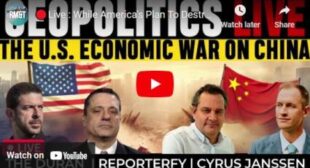
Join us for a riveting live stream live stream event hosted by our esteemed guests, The Duran’s Alex Christoforou and Alexander Mercouris, alongside Cyrus Janssen and Reporterfy Media, will guide us through the intricate web of international relations.
In this captivating discussion, our attention will be firmly fixed on the ongoing China USA Economic war.
However, it’s important to recognize that a significant portion of this economic deceleration can be attributed to US policies designed to curb China’s growth. These anti-China policies seem to follow a familiar pattern in US foreign policy, reminiscent of tactics employed during the Cold War. The primary goal is to hinder economic and technological competition from a major global rival. The first notable instance of such a strategy was the technology blockade imposed on the Soviet Union during the Cold War.
A less well-known but equally significant application of this strategy occurred in the late 1980s and early 1990s when the US deliberately aimed to slow Japan’s economic growth. At that time, Japanese firms were outcompeting their American counterparts in critical sectors such as semiconductors, consumer electronics, and automobiles. In the mid- to late 1980s, US politicians imposed restrictions on Japanese exports to the US market through “voluntary” limits agreed upon with Japan.
They also pressured Japan to artificially inflate its currency, which had the effect of dampening export growth. This deliberate slowdown in economic growth led to financial difficulties for many Japanese companies, eventually culminating in a financial crisis in the early 1990s. During this period, Japan faced constraints on its economic policies due to its reliance on the US for security, which made it more compliant with US demands. However, China today is in a different position. It enjoys greater autonomy in dealing with US protectionist measures because it is less dependent on the US for its security.
This has allowed China to adopt a more flexible approach in responding to US policies aimed at containing its economic rise. The US initiated its efforts to slow China’s economic growth around 2015 when it began viewing China as a strategic rival rather than a trade partner. China’s “Made in China 2025” policy, aimed at achieving leadership in cutting-edge technologies, and the Belt and Road Initiative, focused on infrastructure development, raised alarms in US policy circles.
The playbook employed against China includes tactics such as creating trade alliances that exclude China and imposing tariffs that flout World Trade Organization rules. These strategies were initially introduced by President Trump and have been further reinforced by President Biden. As a result of these policies, China’s share of US imports has steadily declined, with a 29% drop between June 2022 and June 2023.
However, the dynamics of China’s economy are multifaceted, and the decline in exports to the US is not solely responsible for the overall slowdown. In contrast to Japan in the 1990s, China has more room to maneuver and seek alternative trading partners globally. One of its key strategies for countering US protectionism is expanding the Belt and Road Initiative to increase exports to Asia, Africa, and Latin America.
In conclusion, while the US’s attempt to contain China’s economic growth follows a familiar playbook, it is both flawed in principle and likely to encounter significant challenges in practice. China’s ability to forge partnerships worldwide and continue expanding its trade and technological advancements is expected to prevail in the face of US containment efforts.
